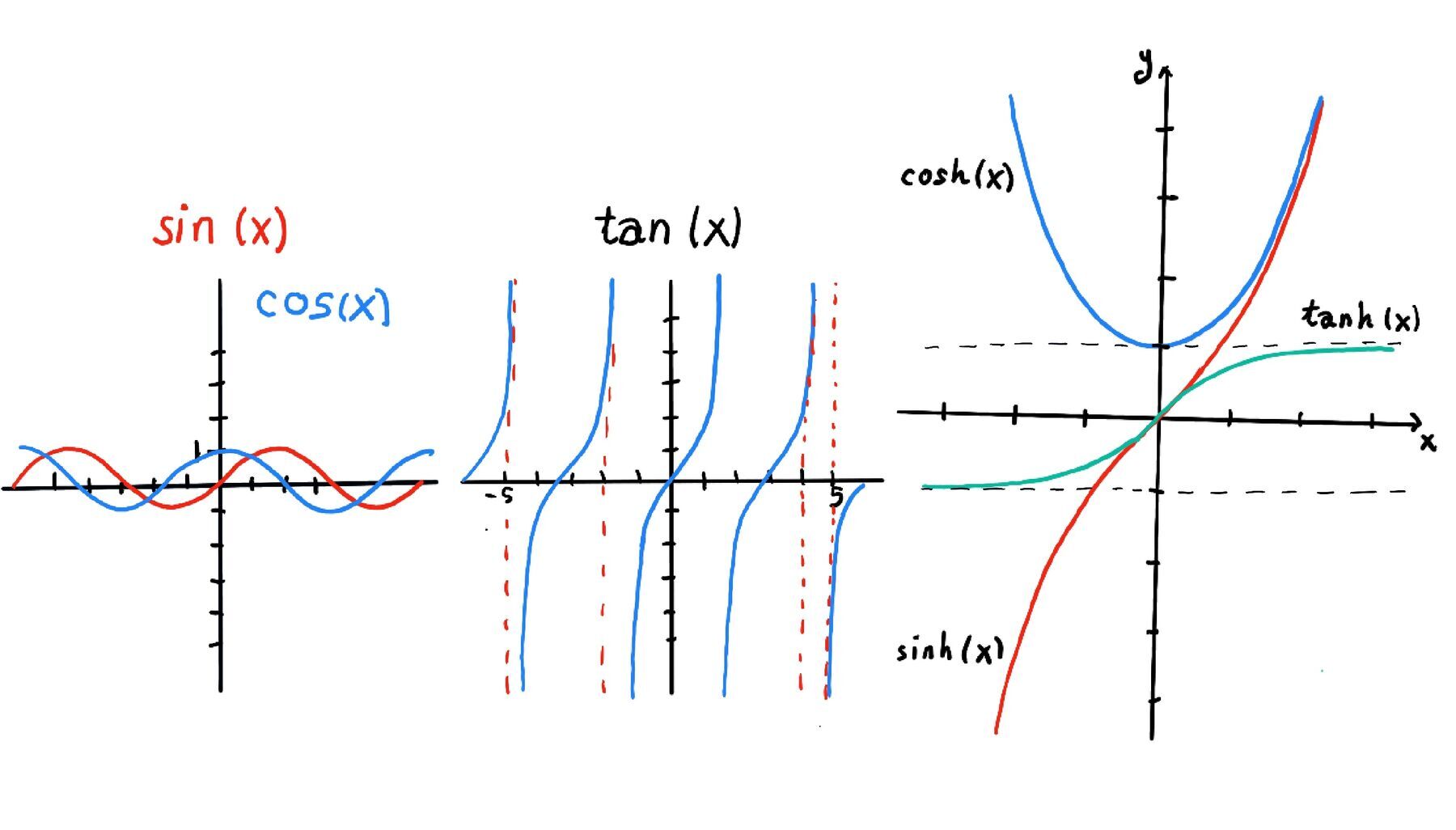
|
 |
 |
As long as algebra is taught in school, there will be prayer in school, Cokie Roberts

Hyperbolic functions are a set of mathematical functions that resemble or mirror many features of the trigonometric functions but arise from the geometry of hyperbolas rather than circles. They are essential in various fields, including calculus, differential equations, special relativity, complex analysis, and more.
Hyperbolic functions are defined using exponential functions $e^x$ and $e^{-x}$. The six primary hyperbolic functions are: Sine Hyperbolic (sinh): $\sinh(x) = \frac{e^x - e^{-x}}{2}$; Cosine Hyperbolic (cosh): $\cosh(x) = \frac{e^x + e^{-x}}{2}$; Tangent Hyperbolic (tanh): $\tanh(x) = \frac{\sinh(x)}{\cosh(x)} = \frac{e^x - e^{-x}}{e^x + e^{-x}}$. Reciprocal functions. Sech (secant hyperbolic): $ \text{sech}(x) = \frac{1}{\cosh(x)}$; Csch (cosecant hyperbolic): $\text{csch}(x) = \frac{1}{\sinh(x)}$, Coth (cotangent hyperbolic): $\coth(x) = \frac{\cosh(x)}{\sinh(x)} = \frac{e^x + e^{-x}}{e^x - e^{-x}}$

Any solution to y’’ = y can be written as: $y(x) = A \cosh x + B \sinh x$ for constants $A, B \in \mathbb{R}$. This is analogous to the trigonometric case for y’’ = -y, where: sin x and cos x solve the equation.
The graph of y = sinh(x) passes through the origin (sinh(0) = 0). It is strictly increasing and unbounded. As $x \to \pm\infty, \sinh(x) \sim \frac{1}{2} e^{x}$ and $\sinh(x) \sim -\frac{1}{2} e^{-x}$.
The graph of y = cosh(x) has a unique minimum at (0, 1), cosh(x) ≥ 1 and increases exponentially in both directions (away from the origin). As ∣x∣→∞ (it’s an even function), $\cosh(x)\sim \frac{1}{2} e^{|x|}.$
tanh(x) is strictly increasing with horizontal asymptotes ±1; $\lim_{x \to \pm\infty}\tanh(x) = \pm 1.$
Derivatives: $\frac{d}{dx}\mathbb{arsinh}(x) = \frac{1}{\sqrt{x^2+1}}, \frac{d}{dx}\mathbb{arcosh}(x) = \frac{1}{\sqrt{x-1}\sqrt{x+1}}, \frac{d}{dx}\mathbb{artanh}(x) = \frac{1}{1-x^2}.$
Examples: sinh(2) = (e^2 - e^-2) / 2 ≈ 3.63. Solve the equation cosh(x) = 2: cosh(x) = 2 => x = ± arccosh(2) = $\pm\ln(2+\sqrt{3})\approx \pm 1.31696.$
Hyperbolic functions are analogs of trigonometric functions (sine, cosine, etc.), but they are defined using the exponential function and relate to the geometry of a hyperbola rather than a circle. When extended to complex analysis, these functions exhibit fascinating properties, periodicity, and applications in physics, engineering, and pure mathematics.
The hyperbolic sine (sinh), hyperbolic cosine (cosh), and other related functions are defined using the exponential function $e^z$, where z is a complex number. For a complex variable z = x + iy, the definitions are:
$cosh(z) = \frac{e^z + e^{-z}}{2}, sinh(z) = \frac{e^z - e^{-z}}{2}, \tanh(z) = \frac{\sinh(z)}{\cosh(z)} = \frac{e^z - e^{-z}}{e^z + e^{-z}}$
Hyperbolic Cotangent: $\coth(z) = \frac{\cosh(z)}{\sinh(z)}$, Hyperbolic Secant: $sech(z) = \frac{1}{\cosh(z)}$, Hyperbolic Cosecant: $csch(z) = \frac{1}{\sinh(z)}$
cos(x + iy) =[Angle Addition Formula: cos(A + B) = cos(A)cos(B) − sin(A)sin(B). Applying this to z = x+ iy, we let A = x and B = iy:] cos(x)cos(iy) -sin(x)sin(iy) =[Now we substitute cos(iy) = cosh(y) and sin(iy) = isinh(y)] cos(x)cosh(y) - isin(x)sinh(y).
Addition formulas: $\cosh(z_1 + z_2) = \cosh(z_1)\cosh(z_2) + \sinh(z_1)\sinh(z_2), \sinh(z_1 + z_2) = \sinh(z_1)\cosh(z_2) + \cosh(z_1)\sinh(z_2). \sinh(2z) = 2\sinh(z)\cosh(z), \cosh(2z) = \cosh^2(z) + \sinh^2(z)$.
For complex argument z = x + iy: $\cosh(x + iy) = \cosh(x)\cos(y) + i\sinh(x)\sin(y), \sinh(x + iy) = \sinh(x)\cos(y) + i\cosh(x)\sin(y)$
Taylor series expansion. Hyperbolic functions are entire functions (analytic everywhere in the complex plane), and their Taylor series around z = 0 are: $\sinh z = z + \frac{z^3}{3!} + \frac{z^5}{5!} + \frac{z^7}{7!} + \dots = \sum_{n=0}^{\infty}\frac{z^{2n+1}}{(2n+1)!}, \cosh z = 1 + \frac{z^2}{2!} + \frac{z^4}{4!} + \frac{z^6}{6!} + \dots = \sum_{n=0}^{\infty}\frac{z^{2n}}{(2n)!}$